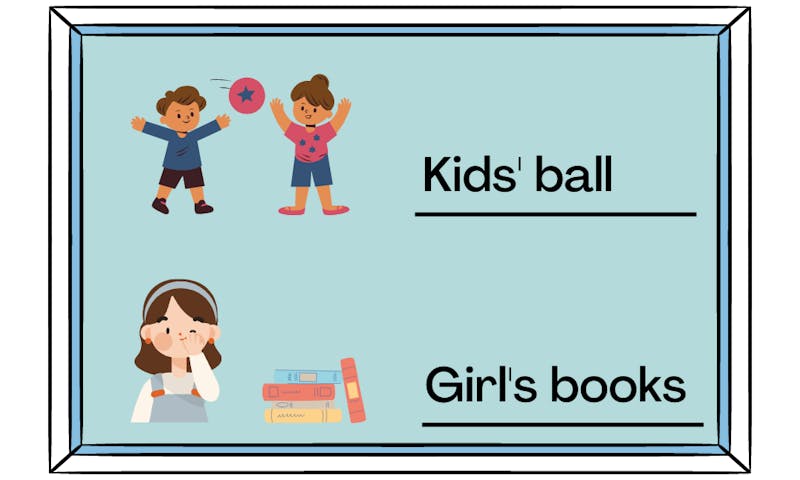Nouns are one of the first types of words that you learn about in your early elementary years. By now, you might already know that a noun is a person, place or thing, and that they often serve as the subject of a sentence.
As you get further into learning about nouns, you’ll find that there are multiple types. Common nouns are generic ones that don’t provide a lot of detail. For example, the word country is a common noun, but France isn’t because it gets more specific about the place.
Proper nouns are ones that you use every day, since they are often names. These nouns are capitalized to show their significance. Sometimes, these and other types of nouns need a few changes to make it clear that they show the subject is in possession of something.
Teacher Tips for Handling Singular Possessive Nouns
When a noun is singular, you must add the apostrophe and "s" to the end. You don't have to make any other changes to the ending letter.
Here are a few examples of possessive nouns to help you see how this looks.
- book's
- car's
- person's
- puppy's
Flashcard Checkpoint
Flip the flashcard to reveal the missing possessive noun. Did you guess correctly?
Adding "S" to Plural Nouns
Watch Students' Grammar Improve by plural nouns. After exploring how singular nouns turn into their possessive form, you might start to wonder how you'll handle words that end in the letter "s." After all, having two of the same letter at the end of a word might look a bit clunky or repetitive.
Since most nouns end in "s" when they are in their plural form, you can simply leave off the extra letter and place the apostrophe at the end. Check out these common plural nouns that have been changed into possessives.
- babies'
- employees'
- cows'
- gamers'
It's Okay to Leave Its Alone
Occasionally, grammar rules have to be relaxed to accommodate the fact that other words can make things confusing. It's is already in use as a contraction that means "it is." If you were to add the usual apostrophe and "s" to the word "it," it would look like a contraction.
The rules change when you are dealing with this word in the possessive form. All you have to do with this word is drop the apostrophe. For example, you will write about "its fluffy fur" or "its favorite food."
How to Handle a Compound Noun's Change to Possessive
Compound and hyphenated words can also make things a little tricky when you want to make them possessive. Fortunately, they also aren't too hard to figure out once you know what you are doing. For these, you add the apostrophe and "s" to the end like you would with singular nouns.
To improve your understanding, you can look at these examples of possessive nouns for compound and hyphenated words.
- Check out my father-in-law's new tractor.
- Do you know the Rocky Mountain National Park's hours?
- Look at this t-shirt's awesome graphic!
- Make sure to stop by the vice principal's office today.
Add "S" to Only the Last Noun's Ending for Shared Possession
Sometimes, you'll have two nouns in a sentence that share ownership of something. For instance, you might want to show that both Kylie and Amina share a locker. In this case, you only need to add the possessive apostrophe and "s" to the last noun in the sentence.
For this example, you would write, "Kylie and Amina's locker."
Indicate Separate Ownership by Adding "S" to Both Nouns
You will also run into situations where the two nouns have separate ownership of something. With these, you give both nouns an apostrophe and "s" to show that each one has sole ownership, even if you are talking about a similar object or thing.
Here are some examples of possessive nouns with separate ownership:
- Jason's and Clay's bikes were left outside at the park by accident.
- Will you please fill the dog's and cat's food bowls?
- Mrs. Smith's and Mr. Clark's classrooms are right down the hall from the bathroom.
Possessive Nouns Quiz 📚
Test your knowledge with our quick possessive nouns quiz using examples that you should be familiar with. Got a question wrong? Don't worry. Press reset and try again.
True or false? You always add an apostrophe to its in the possessive form, making it's.
Choose the best answer from the choices below
True or false? You only need to add an apostrophe to the last noun in a sentence where two nouns have shared ownership. For example, Kylie and Amina's locker.
Choose the best answer from the choices below
Which sentence is correct? Terry_ jumper is in the dog_ bed.
Choose the best answer from the choices below
Which of the following sentences correctly uses possessive nouns and apostrophes?
Choose the best answer from the choices below
Conclusion
Learning how to make nouns possessive is fun, and it adds a new level of depth to your writing when you know how to add that apostrophe and "s" or leave it off. Now, you can take it one step further by exploring possessive adjectives. Words like "my" or "your" also add more definition to your writing, and you'll find that using them is just as easy as what you're doing now with possessive nouns.
